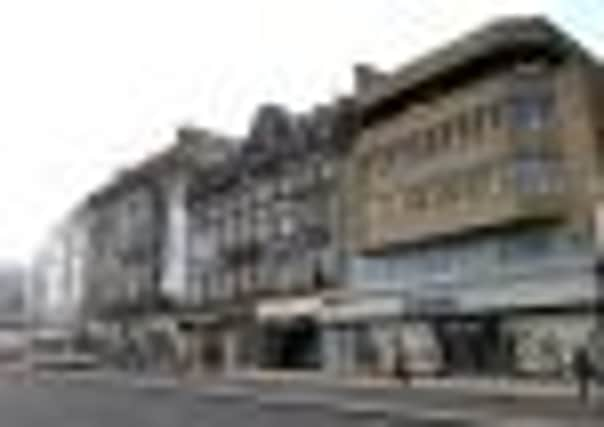Graham Birse: Why we all have to care about the high street crisis


Retail analysts have been quick to attribute recent closures to a failed business model – one that was slow to respond to the twin challenges of declining household incomes and footfall on the one hand and the rise of the convenience and price of internet shopping on the other.
While that may be true, reports of the death of the high street may be a little premature. The Scottish Retail Consortium reported this week the footfall in Scotland was up, one of only four areas in the UK to record an increase.
Advertisement
Hide AdAdvertisement
Hide AdFor every Jessops or Comet, there is apparently a Dixons or a John Lewis, where business models flex in response to consumer trends and shoppers find product, price and service, in store or online.
Clearly, consumers want the best product, best price and best service, delivered in the most convenient way. In the click-and-collect age, retailers which do not have a multi-channel offering risk joining the growing list of species on the endangered list.
To those of us who do not earn our living in retail, does any of this matter? After all, industries and companies have waxed and waned throughout economic history, surely these latest casualties are further evidence of the decline of high street retail – harsh but inevitable?
If you think about it, it matters for two reasons. The first is jobs. Although retail employment is declining, the sector still employs 11 per cent of the workforce in Edinburgh and 13 per cent in Scotland, many of them in entry level roles. Retail is an environment in which skills such as team building, service giving, punctuality, financial responsibility and many more can be acquired and applied to a career, in or out of retail.
Moreover, at a time when youth unemployment is Edinburgh is DOUBLE the adult rate, we risk creating a generation of dispossessed young people by further restricting their opportunity.
The second is environment. Taking retail out of the equation has evidently blighted many high streets and has become so serious that the UK government recently offered a series of cash prizes to towns and cities in England and Wales which could come up with creative solutions to the problem.
While that may sound desperate, it at least acknowledges the scale of the problem and the need for a coherent policy response.
In Edinburgh, we are fortunate to have an elegant capital city in which year-round festivals and events attract visitors and shoppers from far and wide. But even here, our offering, particularly on Princes Street, has become patchwork where tartan-fronted stores belting out bagpipe music have replaced household brands.
Advertisement
Hide AdAdvertisement
Hide AdSo what to do? In Edinburgh, we still have many tremendous assets and strong retail performers. By focussing on investment in public realm improvements, creating an attractive, bright and secure environment for pedestrians, supported by effective marketing, signposting and promotion, we will attract lifestyle retail brands and niche shops which thrive in such a space.
The redevelopment of the St James Centre is just such a magnet, and we should do all we can to persuade its investors to begin work soon. We should also spend less time agonising over the relative merits of such a development in an exhaustive planning process, and more focussing on the benefits for employment.
The city’s business improvement district, Essential Edinburgh, has done some fantastic work in belt-and-braces public realm, picking up litter, improving signposting, security and the like in Princes Street, George Street and Rose Street. It has developed an imaginative plan to take this still further by proposing marketing campaigns to bring more people into town as the tram project opens in 2014, and the roadworks are replaced by an efficient rapid transit system. The proposal needs more from the City Chambers.
• Graham Birse is director of the Edinburgh Institute at Edinburgh Napier University.
We need to sharpen focus – fast
BY Sarah Boyack MSP
THE new year has brought more bad news on the retail front. In the last two weeks, three of our best-known retailers went into administration.
While there are hopes that Hilco might salvage part of HMV, Blockbuster and Jessops have gone.
The huge pressure that people are under financially tells part of the story. This week’s statistics show that, while Scottish unemployment fell, employment in Scotland fell by more despite increasing across the UK. This suggests many Scots, especially women, are giving up seeking work.
The shop workers’ union Usdaw estimated that the average Scottish family is now £460 a year worse off as a result of the UK Government’s hike in VAT to 20 per cent, then there’s the rising costs of utilities bills. The upshot is that people have less disposable income and many are worried about their jobs.
Advertisement
Hide AdAdvertisement
Hide AdOn top of those challenges, not only are our city centre shops under pressure from out-of-town locations, but internet shopping continues to grow. In recent months, campaigners have criticised Amazon for not paying its share of taxation while receiving Scottish Government support. There needs to be a level playing field.
While the work that city architect Malcolm Fraser has been asked to carry out on town centres is welcome, we need an urgent focus on retail jobs. I believe we need a summit to pull together retailers, unions, business and crucially, local authorities. The Scottish Government needs to act before it’s too late.